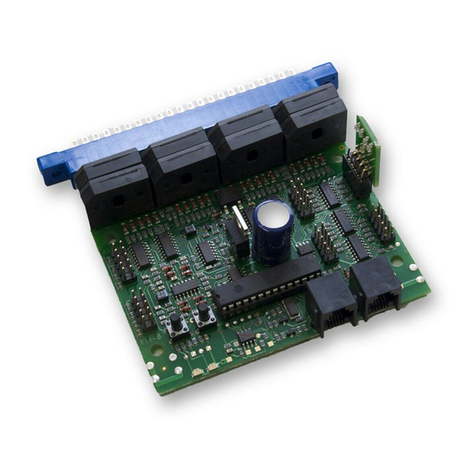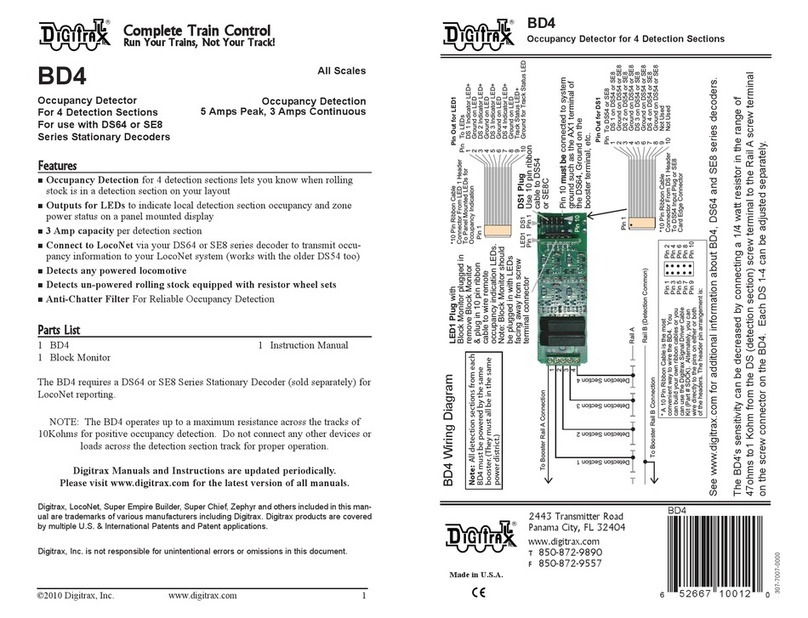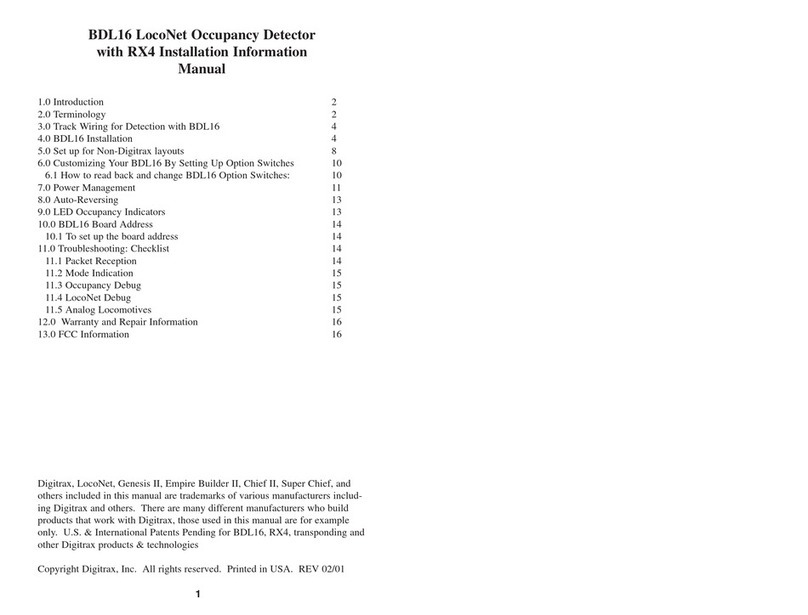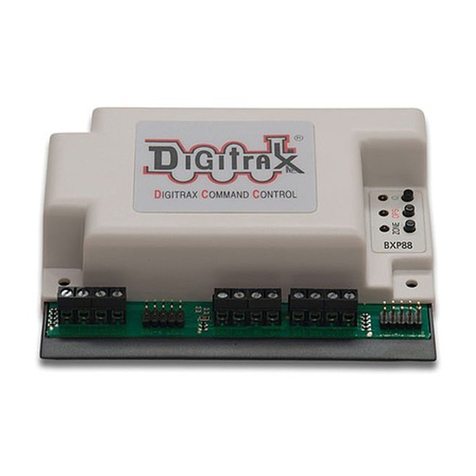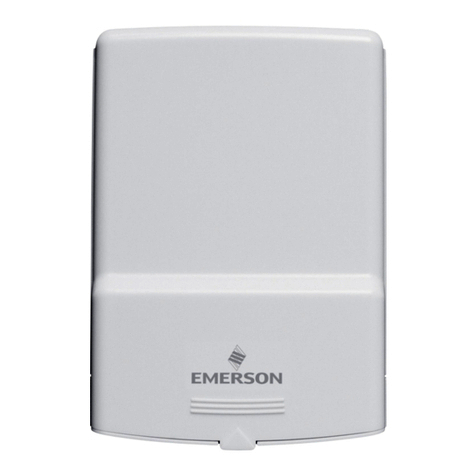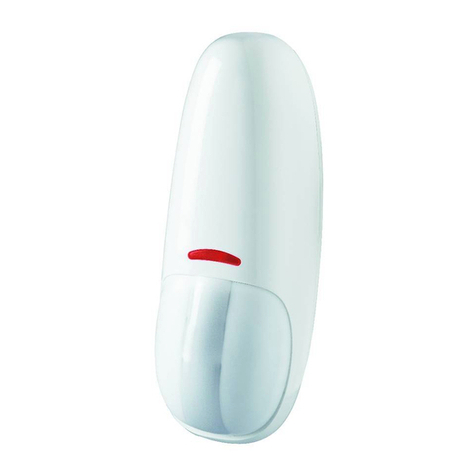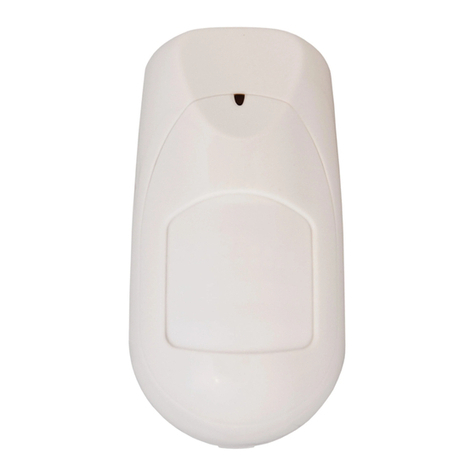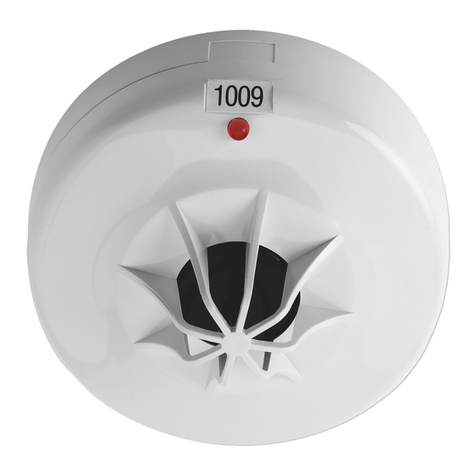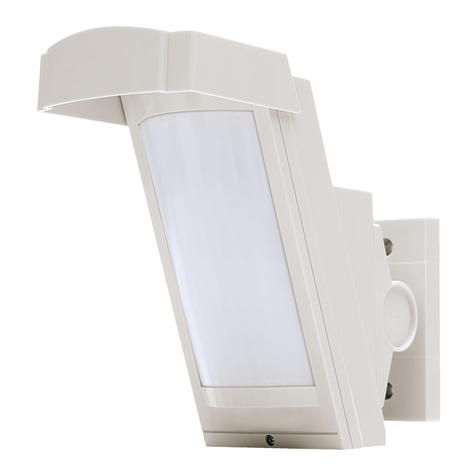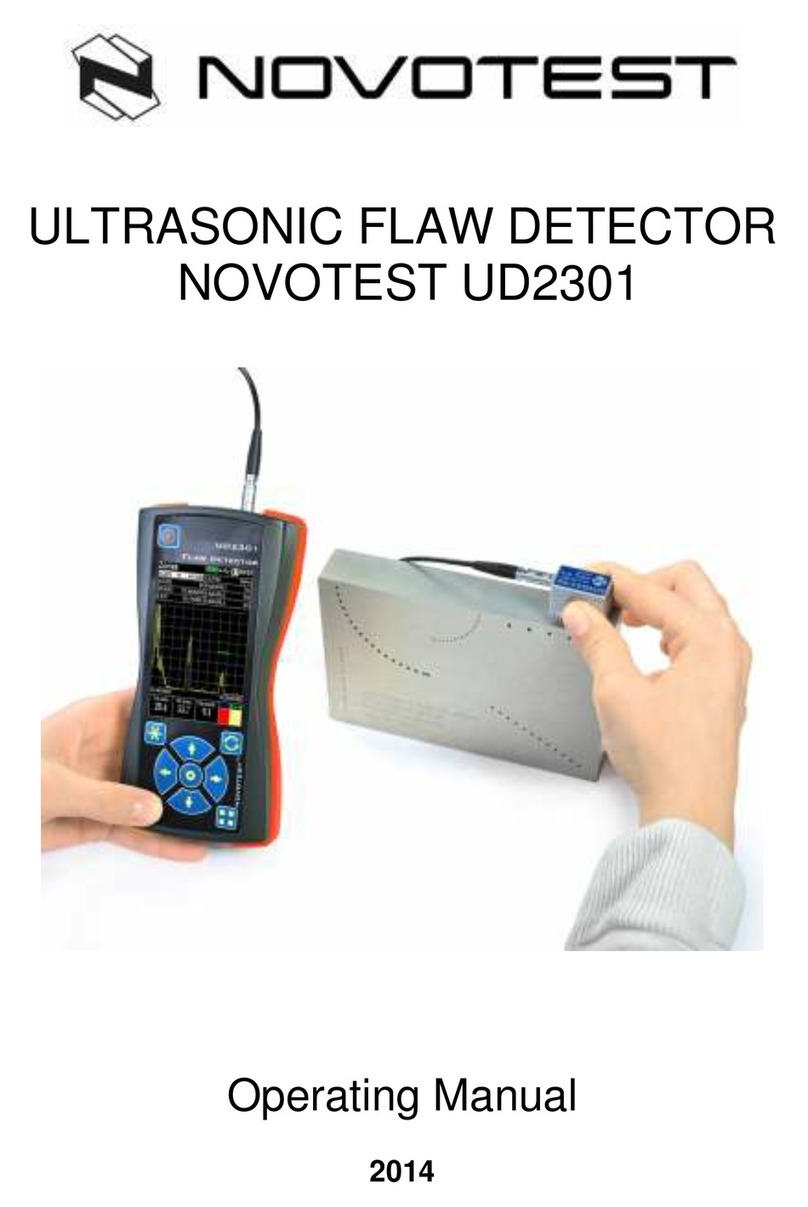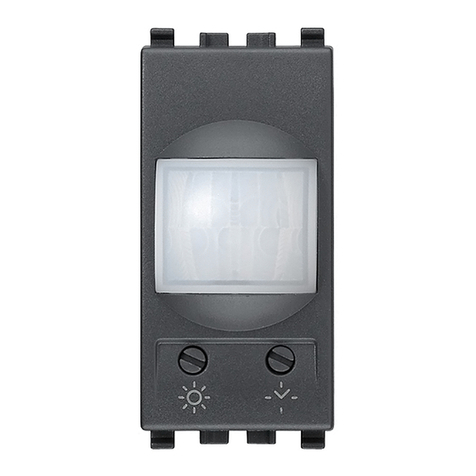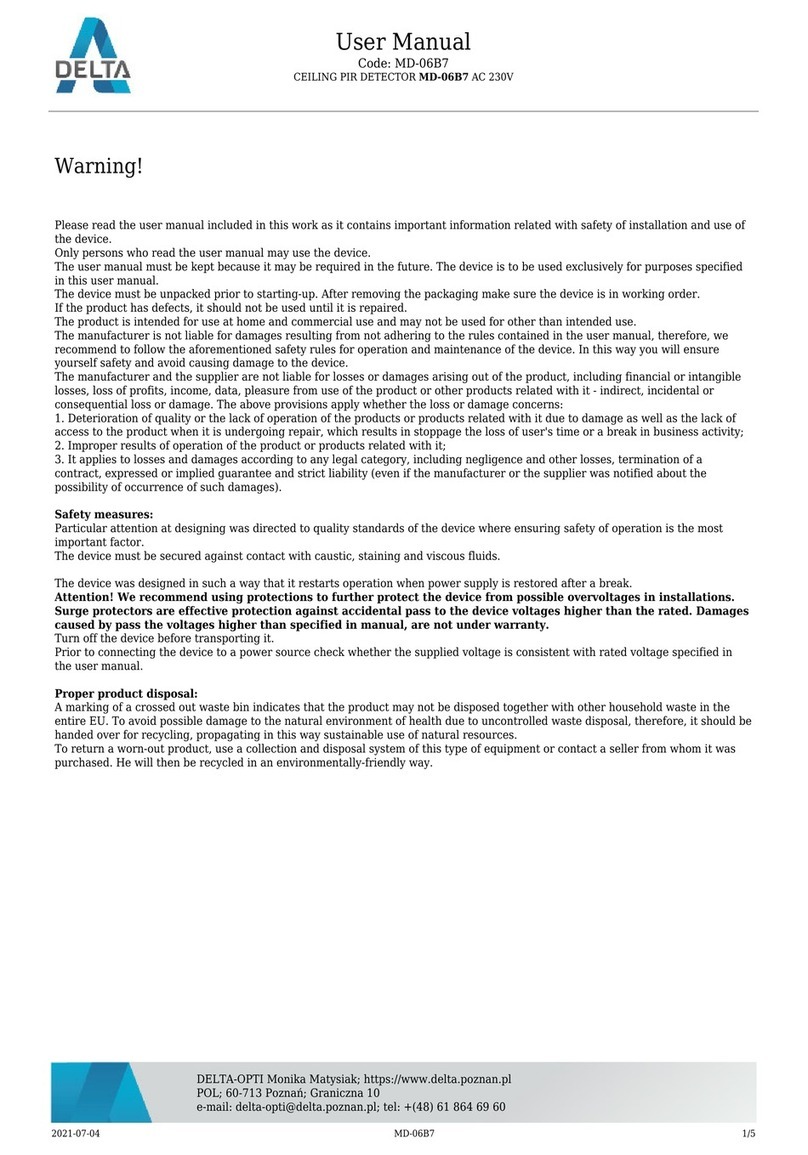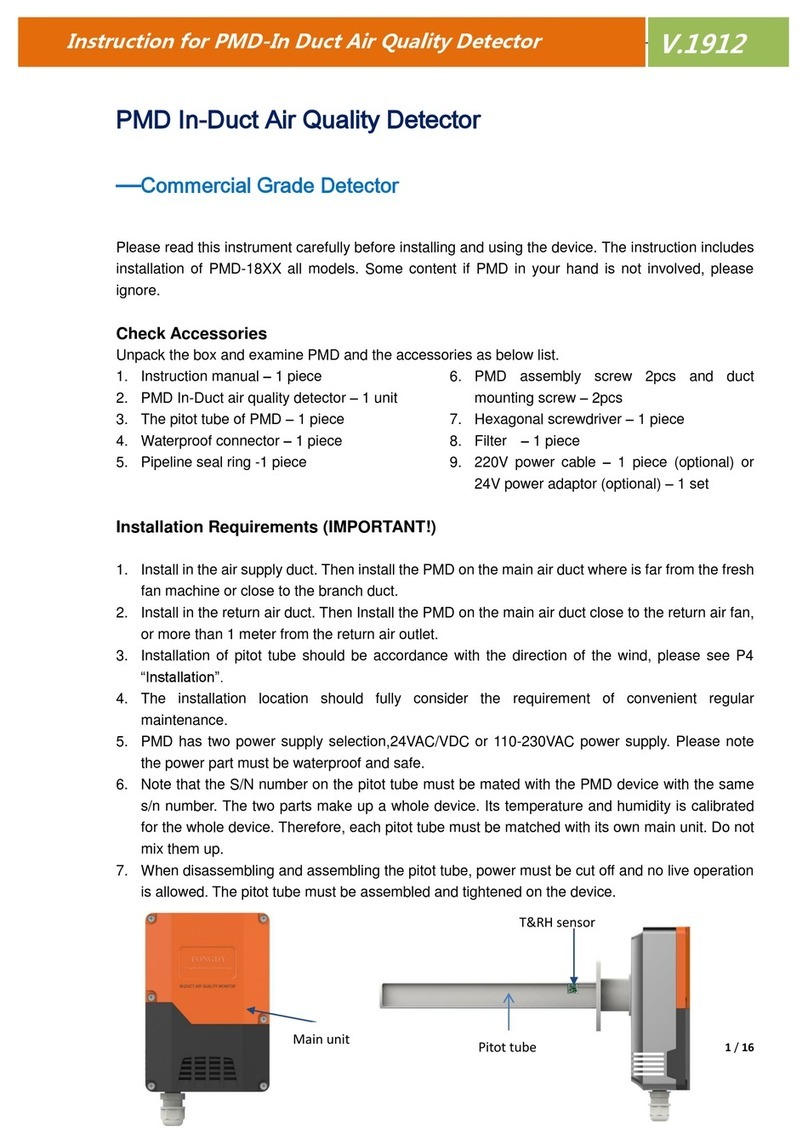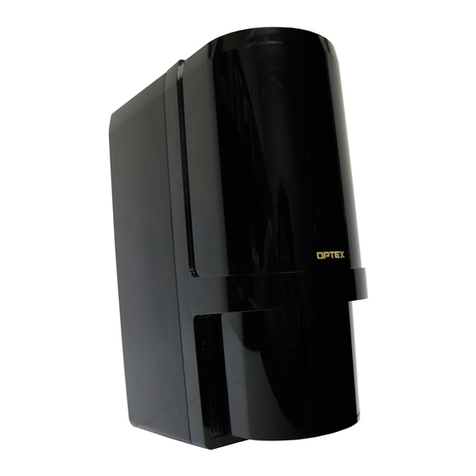Digitrax BDL162 User manual

BDL162
LocoNet Occupancy Detector
For 16 Detection Sections
FFeeaattuurreess
nOccupancy Detection for 16 detection sections lets you know when rolling
stock is in a detection section on your layout
nOutputs for LEDs to indicate local detection section occupancy and zone
power status on a panel mount display
n3 Amp capacity per detection section
nConnect to LocoNet to transmit occupancy information to your LocoNet
system
nDetects any powered locomotive
nDetects un-powered rolling stock equipped with resistor wheel sets
nPlug and Play with Digitrax DCC
nConfigurable for most DCC systems
nAutomatically checks layout status on power up of your system computer
nTransponding with addition of an RX4 Transponder Detector and transpon-
ders in your rolling stock provides additional capabilities:
Identify where specific rolling stock is on your layout
Operations Mode Read Back allows you to read CV values of decoders
equipped with transponders
PPaarrttss
LLiisstt
1 BDL162 1 LT5 Tester
1 44-Pin Connector 1 Instruction Manual
The BDL162 requires a 12V-16V AC or DC power supply which is sold sepa-
rately. Multiple BDL162s can be powered from the same power supply as long
as 100mA is provided for each BDL162. One Digitrax PS12 power supply can
run up to three BDL162s.
Digitrax Manuals and Instructions are updated periodically.
Please visit www.digitrax.com for the latest version of all manuals.
©2002 Digitrax, Inc www.digitrax.com
DDiiggiittrraaxxCCoommmmaannddCCoonnttrrooll
RRuunn
YYoouurr
TTrraaiinnss,,
NNoott
YYoouurr
TTrraacckk!!

©2002 Digitrax, Inc www.digitrax.com 1
BDL162 LocoNet Occupancy Detector
Manual
TABLE OF CONTENTS
1.0 Introduction ..................................................................................2
2.0 Terminology ..................................................................................2
3.0 Track Wiring for Detection with BDL162..................................4
3.1 Direct Home Wiring........................................................................4
3.2 Common Rail Wiring......................................................................7
4.0 BDL162 Installation Requirements ............................................6
5.0 BDL162 Installation for Digitrax layouts ..................................8
5.1 Direct Home Wiring........................................................................8
5.2 Common Rail Wiring......................................................................9
6.0 BDL162 Installation for Non-Digitrax Layouts........................11
7.0 Customizing Your BDL162 -- Setting Up Option Switches ....12
7.1 How to read back and change BDL162 Option Switches: ..........12
8.0 BDL162 Board Address..............................................................14
8.1 To set up the board address ..........................................................14
9.0 Auto-Reversing............................................................................14
10.0 Power Management ....................................................................16
11.0 Occupancy Indication ................................................................16
11.1 LocoNet Devices ..........................................................................16
11.2 LT5 Tester......................................................................................17
11.3 Panel Indicator ..............................................................................16
12.0 Transponding with the BDL162 ................................................18
13.0 Troubleshooting: Checklist ........................................................18
13.1 Packet Reception ..........................................................................18
13.2 Mode Indication ............................................................................18
11.3 Occupancy Debug ........................................................................18
11.4 LocoNet Debug ............................................................................19
11.5 Analog Locomotives ....................................................................19
14.0 FCC Information ........................................................................19
15.0 Warranty and Repair Information............................................20
Digitrax, LocoNet, Super Empire Builder, Super Chief, Zephyr and others included in this
manual are trademarks of various manufacturers including Digitrax. U.S. & International
Patents Pending for BDL162, RX4, transponding and other Digitrax products & technologies.
Digitrax, Inc. is not responsible for unintentional errors or omissions in this document.

©2002 Digitrax, Inc www.digitrax.com 3
interlocking and/or signaling for that track section.
Whole layout common rail is a method of wiring layouts where power dis-
tricts and their boosters are connected electrically by a common rail or com-
mon power bus return wire. This method is traditionally used for conventional-
ly controlled layouts. The track feeds for one rail are connected together to one
output of the power pack. The other rail is gapped and the track feeds are con-
nected to the power pack through block control switches. Whole layout com-
mon rail wiring has a disadvantage when it comes to detection systems because
detectors are not able to independently monitor whether zone power is on or
off. There is no way to tell whether occupancy detection is actually working in
any given detection section.
Detection Section is a section of track gapped on one or both rails and con-
nected to an occupancy detector so that the detector can sense the presence of a
loco (or other specially equipped cars) in that section of track.
Occupancy detector is a device that senses the presence of a locomotive (or
specially equipped cars) in a section of track that is set up for occupancy detec-
tion. Occupancy detectors also provide feedback to indicate occupancy. This
feedback may be in the form of a lamp on a control panel or it may be a feed-
back message sent to the system that can be used by other layout devices. Also
called a block occupancy detector on conventional layouts. Detectors are not
covered by the DCC Standards or Recommended Practices.
Transponder is an electronic device that is installed in rolling stock and can be
assigned a unique address. Transponders provide information to transponder
detectors installed on the layout. This lets the system determine in which detec-
tion section the transponder is currently located. Transponders are included in
many Digitrax premium decoders. TD1 (transponder) & TL1 (transponder with
light output) are available as separate units that can be added to locos with
existing decoders or to other rolling stock without decoders if you want to use
them for transponding only and don't need motor control.
Transponder detector is an electronic device installed in a detection section
on the layout that receives the information broadcast from a transponder. The
transponder detector sends feedback to the system to let it determine the detec-
tion section location of any given transponder at any time. RX4 Transponder
detectors are hosted by the BDL162 and upgrade 4 detection zones of the
BDL162 to be transponder detection zones. In this case, each transponding
zone encompasses 4 detection zones.
The BDL162 is divided into four zones. Each zone supports 4 detection sec-
tions and each zone can be run from a different booster.
©2002 Digitrax, Inc www.digitrax.com 2
11..00
IInnttrroodduuccttiioonn
The BDL162 lets you know when a detection section on your layout is occu-
pied. This occupancy detection capability is the first step toward prototypical
control of your rolling stock, signaling, realistic surround sound effects and
realistic modeling of your layout. Installing the BDL162 on your layout is easy
and will make more prototypical operations possible.
The BDL162 uses digital signal processing (DSP) to give you occupancy
detection for 4 zones, A through D, each with 4 detection sections, for a total
of 16 detection sections. The number of BDL162s you use on your layout is
determined by how many areas of track you want to monitor and how automat-
ed you want your layout to be--more detection sections require more BDL162s.
On your Digitrax system, the BDL162 reports detection section occupancy to
the system via its LocoNet connection. This makes occupancy information
available for use by any LocoNet device hooked up to LocoNet. For instance,
the information can be used by the SE8/SE8c to set signals or by a computer
program for dispatch control. A BDL162 can also host transponder detectors
like the RX4 to let you implement Digitrax transponding for additional dis-
patcher control, surround sound or more layout automation.
On DCC systems without a Digitrax compatible LocoNet command station, a
BDL162 can operate using only the RailSync DCC signal from any DCC sys-
tem. In this case, the BDL16 can report detection information via a user-
installed LED display panel.
22..00
TTeerrmmiinnoollooggyy
Following are some terms you might find useful as you work with the
BDL162.
Direct home wiring is a layout wiring method where each power district and
its booster is electrically isolated. The track within each power district uses a
"common return" wiring method for occupancy detection and/or power man-
agement. Direct home wiring is the wiring method recommended by Digitrax
for safety reasons & also because it makes detection work more prototypically.
Power district is the power wiring, track, components and equipment attached
to that wiring, driven by a single properly isolated booster. The track for a
power district is double gapped on both ends of the district. The BDL162 is
used to set up detection sections within one or more power districts.
Power sub-district is the wiring, components and equipment that are con-
trolled from both power bus wires by their own power management device, for
example a reversing section controlled by an automated reversing device like
the PM42. Power sub-districts are gapped on both ends.
Detection common is the common return used within a properly electrically
isolated power district for implementing occupancy detection.
Security element is the plant, including track, associated with any reporting,

©2002 Digitrax, Inc www.digitrax.com 5
Figure 1:
Direct Home Wiring Example
©2002 Digitrax, Inc www.digitrax.com 4
33..00
TTrraacckk
WWiirriinngg
ffoorr
DDeetteeccttiioonn
wwiitthh
tthhee
BBDDLL116622
The key to proper wiring for occupancy detection is planning. Your layout will
be divided into detection sections that can range anywhere from several inches
to several feet in length. This process is somewhat subjective, with the number
and length of a detection sections varying depending on your layout, train
length and the purpose of the detection.
It is best to plan your detection sections based upon the operations you want to
accomplish on your layout before cutting gaps in the track and installing the
BDL162. For instance, a grade level signal crossing may require from two to
four different detection sections in order to create the effects you want with the
lights and gates operating for trains traveling in either direction. Signal lights
will require information from two detection sections in front of the signal in
order to function like the prototype. Detection is not only useful but critical if
operating a hidden staging area--occupancy detection will let you know which
tracks are occupied in hidden staging areas. In your initial wiring installation,
not all sections have to be connected to BDL162s; they can be connected to a
terminal strip and then to boosters or power management devices. Additional
BDL162s can then be inserted later as needed to further develop your layout.
Additional information about planning and installing the BDL162 can be found
on the web site in the document: Advanced Transponding Application Note
within the Digitrax Application Notes and Technical Information section of the
site. The form, BDL162 Planning Worksheet, is also available in the same sec-
tion for documenting your setup for future reference and trouble shooting.
Whether you are building a new layout or installing your BDL162 on an exist-
ing system, there are two basic wiring formats: direct home wiring and whole
layout common wiring.
3.1 Direct Home Layout Wiring
Digitrax strongly recommends direct home wiring where each power district
and its booster are electrically isolated. This method of wiring has safety
advantages and makes troubleshooting problems easier. In addition, direct
home wiring makes detection work more prototypically.
With direct home wiring, the BDL162 can determine and indicate whether any
of its 4 zones is powered or not (possibly short-circuited) even when there is
nothing on the rails in the detection sections. The BDL162 factory set logic
causes the detection sections to show "occupied" if the associated zone's power
is off (because in this case, detection is not possible). This factory setup match-
es typical prototype detection safety practices. Figure 1 shows an example of a
direct home wiring layout with a single power district with multiple detection
sections. zone A with 4 detection sections (1-4) and zone D with one detection
section (16) has been wired wired in this example.

©2002 Digitrax, Inc www.digitrax.com 7
3.2 Common Rail Wiring
Whole layout common rail is a method of wiring layouts where power districts
and their boosters are electrically connected using a common rail or common
power bus return wire. Whole layout common rail wiring is a disadvantage
when it comes to detection systems since detectors cannot independently moni-
tor whether zone power is on or off so they can't tell whether occupancy detec-
tion is working in any given detection section. See Figure 2: Whole Layout
Common Rail Wiring for an example of wiring a single power district and
one zone with four detection sections.
44..00
BBDDLL116622
IInnssttaallllaattiioonn
RReeqquuiirreemmeennttss
The BDL162 wiring panels should be located near the highest feeder density in
order to minimize the lengths of wires feeding from the track to the BDL162.
Planning the detection sections on the layout and the associated wiring on the
wiring panel is covered in more detail in the technical applications paper,
Advanced Transponding Application Note, available at www.digitrax.com. The
paper includes photographs of a sample installation of the BDL162 with associ-
ated PM42 and RX4. Figure 3 shows suggested minimum space requirements
for installing a single BDL162 and the optional RX4 Transponding Detector on
a wiring panel. See the RX4 manual for more information. Allow space on
your mounting panel for the terminal strip, additional BDL162s and any
PM42s required for power management.
1. Drill mounting holes in the end of the 44-pin connector (Figure 3) or mount
using existing holes and right angle brackets.
2. Screw the connector directly to the wiring panel board.
Figure 3:
BDL162 Installation Space
©2002 Digitrax, Inc www.digitrax.com 6
Figure 2:
Whole Layout Common Rail Wiring Example

©2002 Digitrax, Inc www.digitrax.com 9
5.2 Wiring the BDL162 for Whole Layout Common Rail Wiring
Whole layout common rail wiring cannot independently monitor whether zone
power is on or off so it can't tell whether occupancy detection is working or not
in any given detection section. The BDL162 can be easily configured to over-
come this disadvantage by using detection section 16 to monitor track power--
if track power is on in section 16 then detection is working in sections 1-15.
1. After mounting the 44-pin connector to the board (see section 4.0), label the
connector Using the zones and detection section numbers for easy identifi-
cation of the pins when wiring. (See hint on labeling for wire tracing and
troubleshooting under 5.1.1 wiring for direct home wiring systems.)
2. Solder one wire (AC1) from a 12-16V AC or DC power supply to the pin
12 and the second wire (AC2) from the power supply to the pin N on the
BDL162's 44-pin connector. This powers the BDL162. Multiple BDL162
units can be supplied by a single shared supply as long as you provide at
least 100mA for each BDL162. This power supply should not power any
devices other than BDL162s.
3. Solder the ground wire from the Digitrax booster ground or common (case)
to pin 11 of the 44-pin connector. Nothing is connected to pin M.
4. The end of the wire from each detection section and zone common should
be stripped approximately 1/4” and inserted through the holes in each pin
pair on the connector as indicated in Table 1 and Figure 4. Solder the wire
to each pin. The zone common connections to the booster should be as short
as possible and relatively heavy gauge, since they are common to all four
detectors in the zone. For example, a 12AWG zone connection to the boost-
er should be less than 10 feet for best performance.
5. Wire a 10K resistor from detection section 16 (pin 22) to the detection com-
mon return for the whole BDL162 ( Figure 2). Detection section 16 will be
active when the BDL162 sees track power and you will be able to tell
whether detection is actually available in detection sections 1 through 15.
6. Plug the BDL162 board firmly into the 44-pin connector.
7. Connect LocoNet via one of the BDL162's LocoNet jacks.
8. The first time you apply power to the unit, hold down the switch located
behind the red LED on the BDL162 to set it up for whole layout common
rail operation. The red and green LEDs will light up as power is applied to
the unit. The red LED will go out and the green LED will stay on and
“wink” off twice, approximately every 2 seconds, indicating that it is set up
for common rail wiring and that it is connected to LocoNet and seeing DCC
packets.
The BDL162's option switch 10 is set to “c” (closed) to allow detection section
16 to be used to monitor zone power on a whole layout common rail wired sys-
tem. You can fine-tune the BDL162's characteristics using its option switches
which can be set using a Digitrax compatible throttle or a PC with LocoNet
compatible software that can control turnouts. See Section 7: "Customizing
your BDL162 By Setting Up Option Switches.”
©2002 Digitrax, Inc www.digitrax.com 8
55..00
BBDDLL116622
IInnssttaallllaattiioonn
ffoorr
DDiiggiittrraaxx
SSyysstteemmss
5.1 Wiring the BDL162 for a Digitrax Direct Home Wiring Layout
1. After mounting the 44-pin connector to the board (see section 4.0), label the
top of the 44-pin connector for easy identification of the wires, using zone
letters (A,B,C,D) and detection section numbers (1-16) (See Figure 1).
Note, these are not the same as the pin identification numbers that are
already molded on the connector.
Hint: Some users assign each BDL162 board a letter designation to use
with the detection section number for tracking outputs. For example the first
BDL162 board would be “A” and the detection sections connected to it
would be labeled “A1”, “A2”...“A16” on the wiring panel terminal strip, on
the rough layout and on the layout diagram for easier troubleshooting.
2. Solder one wire (AC1) from a 12-16V AC or DC power supply to the pin
12 and the second wire (AC2) from the power supply to the pin N on the
BDL162's 44-pin connector. This powers the BDL162. Multiple BDL162
units can be supplied by a single shared supply as long as you provide at
least 100mA for each BDL162. This power supply should not power any
devices other than BDL162s.
3. Solder the ground wire from the Digitrax booster ground or common (case)
to pin 11 of the 44-pin connector. Nothing is connected to pin M.
4. The end of the wire from each zone common and detection section should
be stripped approximately 1/4” and inserted through the holes in each pin
pair on the connector as indicated in Table 1 and Figure 4. Solder the wire
to each pin. The zone common connections to the booster should be as short
as possible and relatively heavy gauge, since they are common to all four
detectors in the zone. For example, a 12AWG zone connection to the boost-
er should be less than 10 feet for best performance.
5. Plug the BDL162 board firmly into the 44-pin connector.
6. Connect a LocoNet cable into one of the BDL162's LocoNet jacks.
7. Apply power to the unit. The red and green LEDs will light up as power is
applied to the unit. The red LED will go out and the green LED will stay on
and “wink” off once, approximately every 2 seconds, indicating that it is
connected to LocoNet and seeing DCC packets.
The BDL162's option switches are factory set at the values that will work for
most direct home wired layouts. You can fine-tune the BDL162's characteris-
tics using its option switches which can be set using a Digitrax compatible
throttle or a PC with LocoNet compatible software that can control turnouts.
See Section 7: "Customizing your BDL162 By Setting Up Option Switches.”

©2002 Digitrax, Inc www.digitrax.com 11
©2002 Digitrax, Inc www.digitrax.com 10
Table 1:
BDL162 44-Pin Connector Pin Out Configuration
Notes:
1) All connector pins are paired top (component side) and bottom (sol-
der side) except 11/M and 12/N. For 6 Amp current rating with 3 Amp
connector pins, track/zone wires must be connected to both pin pairs:
e.g. Zone A = pins 1 & A (See Figure 4).
2) Letters G, I, O & Q are not used as pin designations on the connector.
3) Power connections should be made to a power supply dedicated to
BDL162 use only. Multiple BDL162 units can be supplied by a single shared
supply as long as you provide at least 100mA for each BDL162.
4) The Ground connection, pin 11, must be made to the booster for correct
BDL162 operation.
Top
Pin
Bottom
Pin
Name
Connect To
1
A
Zone A
Connection to booster for Zone A
2
B
DS 1
Isolated track section for Detection Section 1
3
C
DS 2
Isolated track section for Detection Section 2
4
D
DS 3
Isolated track section for Detection Section 3
5
E
DS 4
Isolated track section for Detection Section 4
6
F
Zone B
Connection to booster for Zone B
7
H
DS 5
Isolated track section for Detection Section 5
8
J
DS 6
Isolated track section for Detection Section 6
9
K
DS 7
Isolated track section for Detection Section 7
10
L
DS 8
Isolated track section for Detection Section 8
11
Ground**
LocoNet/BDL162 ground to Booster
case/common ground
M
Nothing attached to this pin
12
AC Power 1*
Power input to BDL162 : AC 12V to 15V, or
+DC 12V to 15V
N
AC Power 2*
Power input to BDL162 : AC 12V to 15V, or
+DC 12V to 15V
13
P
Zone C
Connection to booster for Zone C
14
R
DS 9
Isolated track section for Detection Section 9
15
S
DS 10
Isolated track section for Detection Section 10
16
T
DS 11
Isolated track section for Detection Section 11
17
U
DS 12
Isolated track section for Detection Section 12
18
V
Zone D
Connection to booster for Zone D
19
W
DS 13
Isolated track section for Detection Section 13
20
X
DS 14
Isolated track section for Detection Section 14
21
Y
DS 15
Isolated track section for Detection Section 15
22
Z
DS 16
Isolated track section for Detection Section 16
Figure 4:
Connecting Zone & Detection Section Wires to the 44-Pin Connector.
66..00
BBDDLL116622
IInnssttaallllaattiioonn
ffoorr
nnoonn
DDiiggiittrraaxx
LLaayyoouuttss
To make set up simpler and easier for non-Digitrax layouts to use the BDL162,
there are two quick configuration buttons that let you set up your unit to work
with either direct home or whole layout common rail without using a Digitrax
throttle or computer.
1. If you are using direct home wiring, use Section 5.1 as an example for
wiring detection sections. If you are using whole layout common rail
wiring, use Section 5.2 as an example for wiring detection sections.
2. Connect the left-most pin of the RJ12 socket (the RailSync pin) to Rail A
output of your system.The source of the DCC signal must match the DCC
signal being sent by the booster to the detection sections handled by the
BDL162. It is best that this signal stays active even when the booster output
is shorted or disconnected from the BDL162 zone inputs, for example by a
PM42 Power Manager.
3. Configure the BDL162 for your wiring system
a) For direct home wiring layouts, the “ID” switch behind the green ID
LED is held down when AC power is first applied, the BDL162 will oper-
ate on direct home layouts (the factory setting). When DCC packets are
supplied to the RailSync pin of the RJ12 connector the ID LED will be lit
and “wink” off once every 2 seconds to indicate direct home operation is
selected.
b) When operating on a whole layout common rail system, the “OPTION”
switch behind the red option LED is held down when AC power is first
applied to the BDL162. When DCC packets are supplied to the RailSync
pin connector the ID LED will be lit and “wink” off twice every 2 seconds
to indicate whole layout common rail operation is selected.
Note: If either switch is pressed when the BDL162 is first powered up, the
BDL162 will be re-configured.

©2002 Digitrax, Inc www.digitrax.com 13
Table 2:
BDL162 Option Switches (OpSw)
The following table shows what each OpSw is used for when it is set for
thrown or closed. Factory settings are indicated by shaded boxes.
NOTE: If a turnout switch number on the layout matches the OpSw number
being set during this process, the turnout will be activated during the OpSw
setting. Once the BDL162 OpSw configuration is completed and you have exit-
ed option switch setup mode (See section 7.1, Step 5), simply reset the turnout
to the desired position. This will have no affect on the OpSw settings of your
BDL162.
OPSW
t = thrown
c = closed
01
Set up for operation with direct
home wired layouts (Digitrax
recommended wiring)
Set up for whole layout
common rail wired layouts
05
Disable Transponding
Enable Transponding
09
Detection sections show
occupied when zone power is
off
No forced occupied
detection when zone power
is off
10
Use detection section 16 as a
normal detection section.
Use detection section 16 as
zone power ON qualifier for
whole layout common rail
wiring
11
Allow this BDL162 to be the
master.
Do not allow this BDL162
to be master
12
Allow this BDL162 to terminate
LocoNet
Do not allow this BDL126
to terminate LocoNet
13
Power up delay 5 seconds for
DB150 compatibility
Power up delay 1/2 second
19
Use regular threshold sense
DCC occupancy. (approx
22 Kohms minimum)
Use high threshold sense
DCC occupancy (approx
10 Kohms minimum)
25
16 LEDs show occupancy
Drive 16 occupancy LEDs
from SWITCH commands
(not occupancy)
26
Occupancy LEDs decoded
from track DCC switch
commands
Occupancy LEDs decoded
from LocoNet SWITCH
commands
40
Direct home wiring compatible
Make all option switches
factory settings
©2002 Digitrax, Inc www.digitrax.com 12
77..00
CCuussttoommiizziinngg
YYoouurr
BBDDLL116622
----
SSeettttiinngg
UUpp
OOppttiioonn
SSwwiittcchheess
The option switches and settings you can use to customize your BDL162 are
indicated in Table 2. These option switches are set up using your Digitrax
throttle's SWITCH commands. SWITCH mode is normally used for operating
turnouts by issuing closed ("c") or thrown ("t") commands. In the case of your
BDL162, each switch address is a BDL162 option switch.
7.1 How to read back and change BDL162 Option Switches (OpSw):
1. Power up your BDL162 and connect it to LocoNet.
2. Connect a DT or UT series Digitrax throttle to one of the the BDL162's
LocoNet connectors.
3. Press the switch behind the red option LED for about 1 second, then release
it. The red option and green ID LEDs will flash alternately to let you know
that you are in option switch setup mode.
4. Go into SWITCH mode on your throttle. Dial up the switch number that
corresponds to the OpSw you want to change and issue a closed "c" or
thrown "t" command to set the OpSw to the desired setting. The OpSw is
changed as soon as you issue the SWITCH command. See below for
instructions for specific Digitrax throttles.
5. When BDL162 OpSws are set up as desired, press the switch behind the red
option LED for about 1 second and release it, the BDL162 will exit option
switch set up mode. You can also exit option switch set up mode by turning
off the power to the BDL162 and then turning it back on.
DT100, DT200 or DT300 series throttle, press MODE/DISP key on the throttle
to enter SWITCH mode. Use the throttle to read back each OpSw in Table 2 by
dialing it up on the throttle and looking at its setting (“c” or “t”) in the display. If
you need to make a change to the OpSw simply press the cor tkey to make the
change you want. Once you are finished reading back and changing settings,
simply wait 6 seconds for the throttle to time out and return to “LOCO” mode.
Be sure to complete step 5 above when finished setting OpSws.
UT series throttle, press the RUN/STOP and DISP/OPSW keys at the same
time to enter SWITCH mode. With a UT throttle, you won't be able to read back
the BDL162 OpSw settings but you can change them by dialing up the OpSw
number you want to modify and pressing the ckey. When the LED under the c
key is on, the OpSw is set to closed; when it is off, the OpSw is set to thrown
(the factory setting). When you are finished setting up BDL162 OpSws, return
to LOCO mode by pressing RUN/STOP and DISP/OPSW keys at the same time.
Be sure to complete step 5 above when finished setting OpSws.
DT400 series throttle, press SWCH key to enter into the switch mode. Use the
keyboard to enter the OpSw number and view the current setting for the OpSw
you want to change (“t” or “c” in the display). Press the tor ckey to change the
setting. To return to “LOCO” mode press the EXIT key.

©2002 Digitrax, Inc www.digitrax.com 15
Figure 5:
Reversing Section Wiring Example
©2002 Digitrax, Inc www.digitrax.com 14
88..00
BBDDLL116622
BBooaarrdd
AAddddrreessss
When the BDL162 is connected to LocoNet, it will communicate coded detec-
tion information to the system. If you wish to report BDL162 status to LocoNet
and attached devices or computers that can interpret these messages, you will
probably want to set up a unique board address for each BDL162. Board
addresses can range from 01 to 999. It is recommended that you make a record
of the addresses you use for all devices connected to your layout.
8.1 To set up the BDL162 board address
1. Power up your BDL162.
2. Press the switch behind the green ID LED for about 1 second, then release
it. The green ID LED will blink. The red option LED will not light. This
let's you know that you are in board address set up mode.
3. Connect a DT or UT series Digitrax throttle to the BDL162's LocoNet con-
nector.
4. Go into SWITCH mode on the throttle. Select the switch number that corre-
sponds to the board address you want to set and issue a closed "c" command
to set the board address. The board address is changed as soon as you issue
the SWITCH command. See following instructions for using specific Digitrax
throttles for setting the address.
DT100, DT200 or DT300 series throttle, press the MODE/DISP key on the
throttle to enter SWITCH mode. Use the throttle to dial up the board address
you would like to assign to the BDL162. When the address is in the display,
press the ckey to issue a closed command. This will set the board address for
the BDL162. The green LED will then go steady green to indicate BDL162
Power on.
UT series throttle, press the RUN/STOP and DISP/OPSW keys at the same
time to enter SWITCH mode. With a UT throttle, dial up the board address you
would like to assign to the BDL162. Press the ckey until the corresponding
LED is lit. This will set the board address for the BDL162. The green LED will
then go steady green to indicate BDL162 Power ON. When you are finished
setting up BDL162's board address, return to LOCO mode by pressing the
RUN/STOP and DISP/OPSW keys at the same time to exit SWITCH mode.
DT400 series throttle, press SWCH key to enter into the switch mode. Use the
keyboard to enter the board address number you want to set. Press the ckey to
set the address. To return to “LOCO” mode press the EXIT key or the LOCO key
twice.
99..00
AAuuttoo--RReevveerrssiinngg
Note that an auto-reverse section can only use detection sections that are
contained in a BDL162 zone that is correctly set up for auto-reversing. See
Figure 5: Reversing Section Wiring for a wiring example.

©2002 Digitrax, Inc www.digitrax.com 17
11.3 Panel Indicator Wiring
You can build a display panel with a track schematic and LEDs to indicate
track occupancy by connecting LEDs to the output connectors A, B, C, and D
shown in Figure 6. For a panel display of occupancy status made up with user
supplied LEDs, connect to the four 0.1" 2x5 headers, and wire up LEDs as
shown in Figure 7: LED Panel Indicators Wiring. DigiKey (1-800-DigiKey)
part number M1AXA-1036R-ND is a convenient plug and cable assembly that
you can use to wire LED indicators. Header “A” includes the 4 detection indi-
cators for detection sections 1 to 4 and the zone power indicator for zone A
that includes these four detection sections
The BDL162 incorporates current setting resistors to set the LED current typi-
cally about 3mA. If you use higher LED drive currents you can use external
transistors etc to amplify the LED current.
The LED drive from the BDL162 is active high at about +5 volts above the
BDL162 ground pin, via a 1 Kohm resistor. Note that the ribbon cable includes
separate ground return conductors for each LED that allow a 10 conductor rib-
bon cable to be split into 5 pairs to conveniently route to individual LEDS. Be
sure to connect the +ve active output leads to the LED anodes.
Figure 7:
LED Display Wiring
.
©2002 Digitrax, Inc www.digitrax.com 16
1100..00
PPoowweerr
MMaannaaggeemmeenntt
The BDL162 is designed to operate “downstream” of the Digitrax boosters and
power management devices. The BDL162 is the "last" device in the chain from
booster to power manager to BDL162. It is connected directly to the track
detection section. There should be no other connections to any detection
section that will draw track power or the detection section will always
show occupied.
If a device is used to switch off power feeding the BDL162 and the track it is
connected to, for example, a PM42 Power Manager, it should break the track
power to both the zone and detection common rail. If a device only switches
off a single leg, then it must be placed in the detection common rail wiring.
1111..00
OOccccuuppaannccyy
IInnddiiccaattiioonn
The BDL162 can report occupancy information via the LocoNet connection or
via direct output to a user created LED panel.
11.1 LocoNet Devices
The BDL162 provides occupancy messages to LocoNet that can be used by
computer software for a visual display of occupancy status on the layout or to
other devices on the layout. For instance, the Digitrax SE8 or SE8c can use
these messages to control signals on the layout. See the operations manual of
your computer software or the SE8C for details on installation and operation.
11.2 LT5 Tester
Each BDL162 comes with an LT5 that will help you with layout wiring and
troubleshooting for transponding & detection. The LT5 plugs onto the LED
connections of BDL162 and the LEDS on the LT5 light when detection sec-
tions are occupied. The status of power to each zone is also shown. (Figure 6.)
Figure 6:
LT5 Tester

©2002 Digitrax, Inc www.digitrax.com 19
will plug into one of the 4 occupancy LED headers on the BDL162 and solder
LEDs to the wires to create an array of LEDs (see Figure 6). By plugging this
display array into one of the 4 occupancy LED headers (Figure 5, marked
A,B,C & D), you can see the state of the zone and occupancies for that header.
This allows you to easily check the zone sensitivity (typically 22 Kohms to
give detection). This also aids in the determination of detection number and
activity for a track detection section. Many detection problems are related to
wiring problems or poor connections to the detection section rather than to the
actual BDL162. By using the display array, you can eliminate the wiring issues
from the equation and be sure that the BDL162 is set up correctly.
Remember, if the zone power is OFF, the occupancy LEDs should be set up so
that they will be on to be sure that signaling systems or a CTC/dispatcher will
see the detection section in its most restricted aspect.
13.4 LocoNet Debug
If you are using LocoNet for reporting, be sure that the configuration is correct
for your usage. In normal operations the red “option” LED will blink ON
briefly when valid LocoNet messages are seen confirming a good LocoNet net-
work connection.
13.5 Analog Locomotives
The motor inductance of analog locomotives may in some installations cause
cross talk among the BDL162 detection sections. The addition of a 220ohm,
3 watt, wire wound resistor between the booster track terminals (Rail A and
Rail B on Digitrax boosters) will typically reduce the effect of this cross talk.
Simply use a leaded resistor as a jumper between the booster's two track termi-
nals.
1144..00
FFCCCC
IInnffoorrmmaattiioonn
Radio or TV Interference: (this information is MANDATED by the FCC) This
equipment has been tested and found to comply with the limits for a Class B
digital device, pursuant to part 15 of the FCC rules. These limits are designed
to provide reasonable protection against harmful interference when the equip-
ment is operated in a residential environment. This equipment generates, uses
and can radiate radio frequency energy and, if not installed and used in accor-
dance with the instruction manual, may cause harmful interference to radio
communications. However, there is no guarantee that interference will not
occur in a particular installation. If this equipment does cause harmful interfer-
ence to radio or television reception, which can be determined by turning the
equipment off and on, the user is encouraged to try to correct the interference
by one or more of the following measures:
• Reorient or relocate the receiving antenna.
• Increase the separation between the equipment and the receiver.
©2002 Digitrax, Inc www.digitrax.com 18
1122..00
TTrraannssppoonnddiinngg
wwiitthh
tthhee
BBDDLL116622
The BDL162 is ready to set up four transponding zones with the addition of an
RX4 Transponder Detector. Transponding allows two-way communication with
rolling stock equipped with a transponding decoder or a stand alone transponder.
Many of the Digitrax Premium and FX3decoders are transponder-equipped.
You may need to set the decoder CV61 value to enable transponding. The set up
for transponding operation is covered in the RX4 Installation Manual and in the
Digitrax Decoder Manual.
Transponding allows you to keep track of where individual transponder-
equipped rolling stock is located on your layout. Your dispatcher can keep bet-
ter track of trains, knowing exactly where each train is located. Additional
applications include surround sound specific for each loco, automated train
control, and remote layout operation. Transponding also allows Operations
Mode Read Back of decoder CVs while operating your trains on your layout
providing you additional control over your locomotives.
If you are planning to use Digitrax Transponding with your BDL162 please
allow space to install the RX4 Transponder Receiver as shown in Figure 3.
Additional information about transponding can be found in the RX4 instruction
manual and on the web in the Digitrax Application Notes and Technical
Information Section/Advanced Transponding Application Note.
1133..00
TTrroouubblleesshhoooottiinngg::
CChheecckklliisstt
13.1 Packet Reception
Be sure the green ID LED is ON & is “winking” off about every 2 seconds.
This means that correctly formatted DCC packets are being decoded from the
left most (Railsync) pin of the RJ12 LocoNet socket. For DCC detection, the
same DCC packet signal that drives the booster must be connected to the RJ12
socket's left most pin. If you are using LocoNet and you do not see the green
LED blinking pattern described, check to be sure that the system is powered up
and your LocoNet cable connections are good. You can use your LT-1 to test
the LocoNet cables if you suspect there is a problem with them. If the green
LED on the BDL162 is not lit, check the external power connections.
13.2 Mode Indication
The winking on the green ID LED indicates the primary BDL162 mode. A sin-
gle wink indicates standard Digitrax compatible Direct Home track wiring and
detection logic will be used, a double wink indicates Common Rail wiring and
detection logic is to be used. For Common Rail, all 4 BDL162 zone connec-
tions must be made to the System Common ground point. Be sure the BDL162
configuration is appropriate for your usage.
13.3 Occupancy Debug
Use the LT5 provided with your BDL162 as described in Section 11.2. You can
also build a simple LED display debugger as follows. Use a 10 pin plug and
cable such as DigiKey (1-800-DigiKey) part number M1AXA-1036R-ND that

©2002 Digitrax, Inc www.digitrax.com 20
• Connect the equipment into an outlet on a circuit different form that to
which the receiver is connected.
• Consult the dealer or an experienced radio/TV technician for help.
Note: Any modifications to the equipment not expressly approved by Digitrax
voids the user's authority to operate under and be in compliance with CFR 47
rules, as administered by the Federal Communication Commission. Digitrax
believes any conscientiously installed equipment following guidelines in this
manual would be unlikely to experience RFI problems.
1155..00
WWaarrrraannttyy
aanndd
RReeppaaiirr
IInnffoorrmmaattiioonn
Digitrax guarantees the BDL162 to be free from manufacturing defects for five
years from the date of purchase. These units are not user serviceable. If a
defect occurs, return the unit to Digitrax for service. Digitrax will repair or
replace BDL162s at our discretion at no charge to you for five years from pur-
chase date. This warranty excludes damage due to abuse, such as failure to
properly protect against input over current with a fuse or circuit breaker or
applying excessive input voltage to the unit.
Digitrax will make non-warranty repairs needed because of physical damage or
electrical abuse at fair and reasonable rates.
All warranties on Digitrax products are limited to refund of purchase price or
repair or replacement of Digitrax products at the sole discretion of Digitrax.
In the event that Digitrax products are not installed or used in accordance with
the manufacturer's specifications, any and all warranties either expressed or
implied are void. Except to the extent expressly stated in this section, there are
no warranties, express or implied, including but not limited to any warranties
of merchantability or fitness for a particular purpose.
Digitrax, Inc. reserves the right to make changes in design and specifications
and/or to make additions or improvements in its products without imposing any
obligations upon itself to install these changes, additions or improvements on
products previously manufactured.

Made in U.S.A.
307-1004-0001
BDL162
LocoNet Occupancy Detector
450 Cemetery Street #206
Norcross, GA USA 30071
www.digitrax.com
T770-441-7992
F770-441-0759
Table of contents
Other Digitrax Security Sensor manuals
Popular Security Sensor manuals by other brands
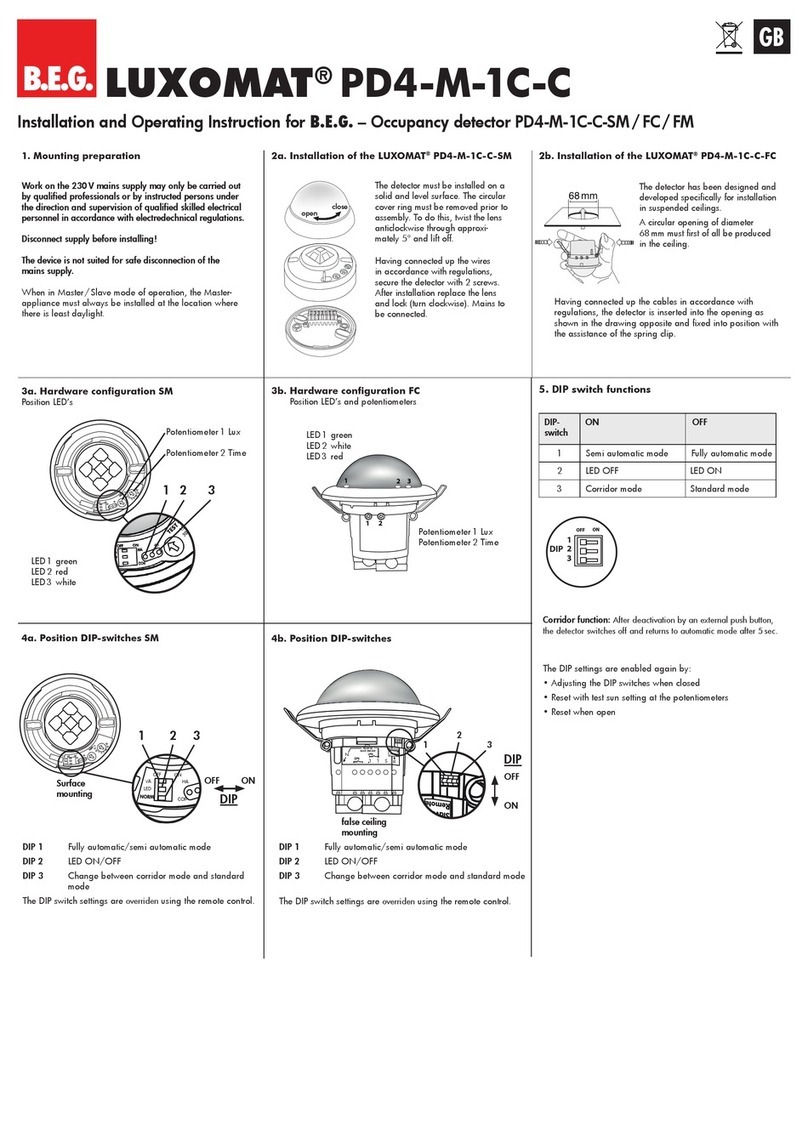
B.E.G.
B.E.G. LUXOMAT PD4-M-1C-C-SM Installation and operating instruction
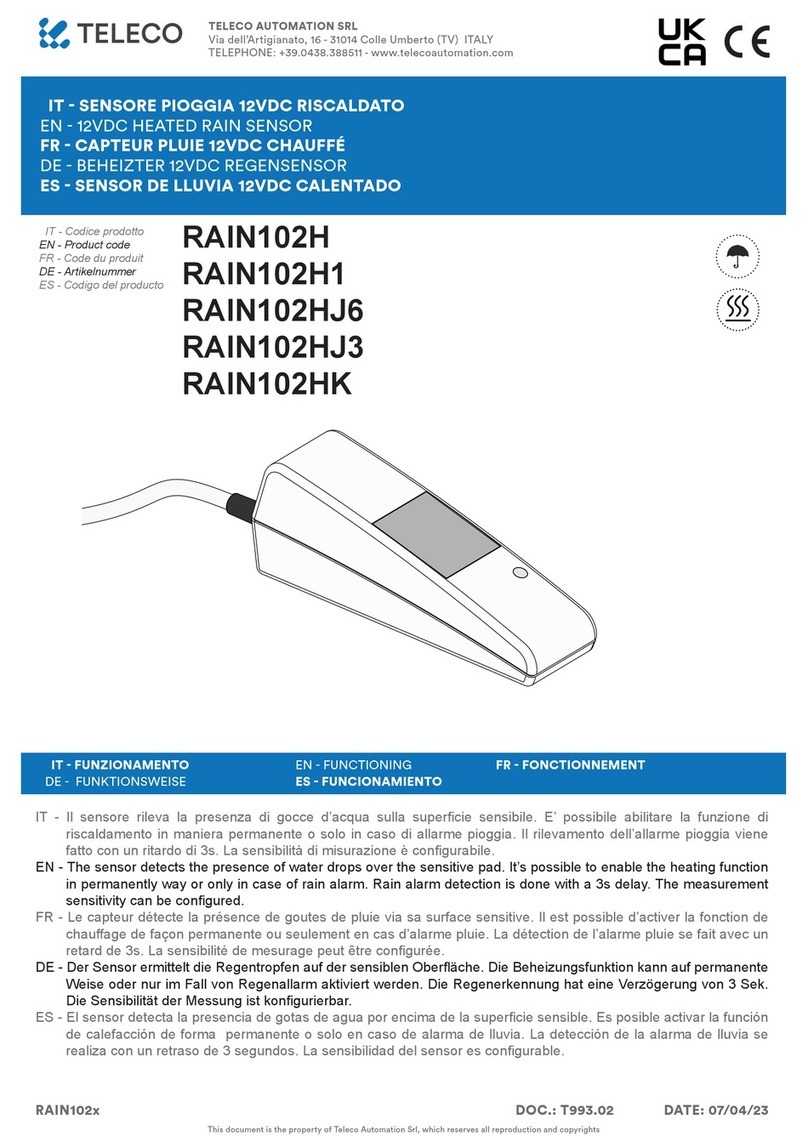
Teleco
Teleco RAIN102H quick start guide
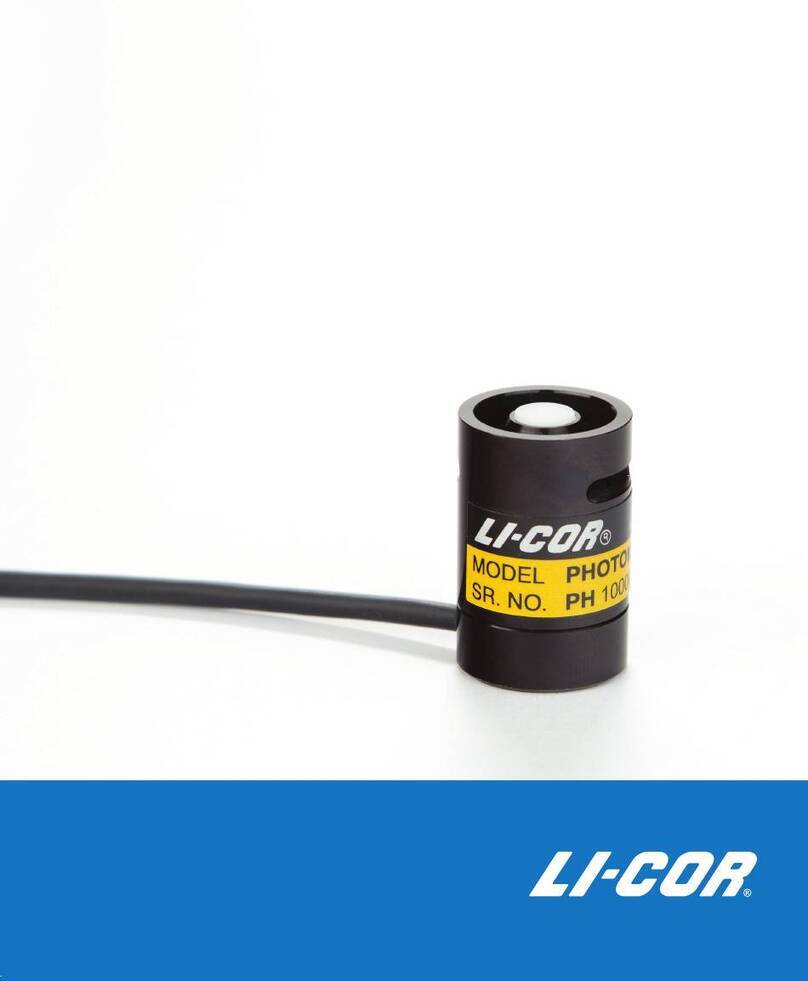
LI-COR
LI-COR LI-210R instruction manual

Gas Clip Technologies
Gas Clip Technologies Multi Gas Clip Operator's manual
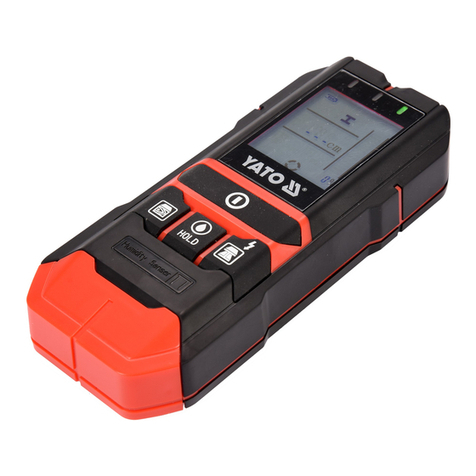
YATO
YATO YT-73138 Original instruction
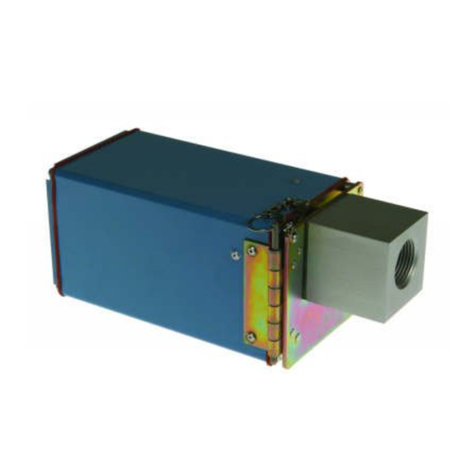
Honeywell
Honeywell C7076A operating instructions
